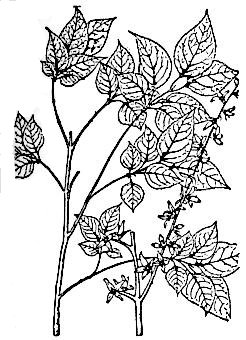- Any Heat disorder, with
Isatis tinctoria-
Ban lan gen.
[6]
- Wind Heat common cold or influenza, with
Isatis
tinctoria- Ban lan gen
Schizonepeta
tenuifolia- Jing jie and
Mentha arvensis-
Bo he.
[6]
- Mumps and erysipelas, with
Isatis tinctoria-
Ban lan gen and
Isatis tinctoria-
Da qing ye.
[6]
- Tonsillitis, with
Isatis tinctoria- Ban
lan gen, Niu bang zi.
[6]
- Dysentery and other acute infectious diseases, with
Isatis
tinctoria- Ban lan gen and
Coptis chinensis-
Huang lian.
[6]
- Initial stages of a Warm febrile diseases, with
Chrysanthemum
indicum- Ye ju hua.
[6]
- Allergic rashes, with
Ephedra sinica- Ma
huang,
Paeonia rubra- Chi shao and
Glycyrrhiza
uralensis- Gan cao.
[6]
- Scrofula, with Xia ku coa, Zhe bai mu and Xuan shen.
[6]
Jin yin hua and Lian
qiao are similar. They are often used together in formulas to cool the Heat and
neutralise Toxins.
Jin yin hua is the sweeter and does not
damage the Stomach Lian qiao is bitter and cold. Small dosages can clear the Heat
and strengthen the Stomach, but overdoses can damage the digestion.
Jin yin hua is used more to disperse external
symptoms, while Lian qiao is specifically used to clear internal Heat from the
chest and diaphragm.
[4]
Stimulates the central nervous system.[4]
[1] Barefoot Doctor's Manual- 1977 Prepared by the Revolutionary Health Committee
of Hunan Province. Original Chinese manual- Victor W. Sidel. Originally published
by Dr Joseph Quin and the Fogarty International centre, Bethdesda (1974). Madrona
Publishers Seattle Washington ISBN 0-914842-52-8
[2] A Complete English Dictionary of Medicinal Terms in Chinese Acupuncture
and Herbalism 1981- Henry Lu Chinese Foundations of Natural Health- The Academy
of Oriental Heritage, Vancouver, Canada.
[3] The Chinese Materia Medica A practical English- Chinese Library of Traditional
Chinese Medicine Publishing House of Shanghai University of Traditional Chinese
Medicine. Director Hu Ximing ISBN 7-81010-111-X/R-110
[4] Translation notes from Gary Seiford and Hocu Huhn- NSW College of Natural
Therapies. Sydney Australia (1982).
[5]
books.google.com.au
The Art of Combining Chinese Medicinals by Dui Yao By Philippe Sionnea
[6] Chinese Herbal Medicine Materia Medica- Dan Bensky and Andrew Gamble- Eastland
Press 1986 Seattle Washington ISBN 0-939616-15-7
Images
1.
lookfordiagnosis.com
2.
[1]
3.
fourflowerswellness.com
4.
alibaba.com
5.
tcmwiki.com
Forsythin (phillyrin), matairesinoside, and betulinic acid, phyillygenin, pinoresinol.[1]
References
[1] Chinese Herbal Medicine Materia Medica- Dan Bensky and Andrew Gamble- Eastland
Press 1986 Seattle Washington ISBN 0-939616-15-7
 Forsythia
suspensa. Weeping Forsythia
Family: Oleaceae
Forsythia
suspensa. Weeping Forsythia
Family: Oleaceae


 连
翘
心
Lián qiáo xīn Seed
hearts
连
翘
心
Lián qiáo xīn Seed
hearts
